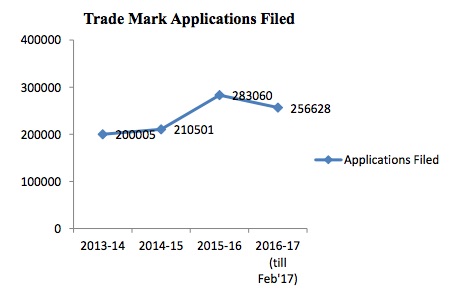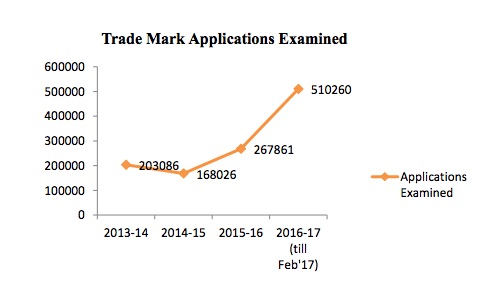29 May, 2017
With continuous reforms in the landscape of the Intellectual Property (IP) system, India is emerging as one of the dominating player in the modern world economics. Recently, the Government of India ushering into the new era, announced the new Trade Marks Rules, 2017 thereby repealing the Trade Marks Rules, 2002 and apart from simplifying and streamlining the trademark registration process it also upgrades the IP system at par with the International Standards. The endeavour has been towards refurbishing the preceding scenario and establishing of a productive IP based system at all statutory, administrative and judicial levels developing India’s image as an IP friendly nation in global scenario.
The journey of the Indian Trade Marks office has been a long and progressive one. The Indian IP Office with an objective of achieving a strong, streamlined and efficient processing framework has been renovating various procedural functions. Going green in line with the Digital India campaign and reducing dependency on paper, the electronic mode of filing and correspondence is the call of this era resulting in inter alia expeditious registration of trademarks. The right holders have welcomed these modifications as they have led to accelerated examination of trade mark applications within one to two months of filing, speedy issuance of registration certificates and streamlining of the online database.
As per information shared by Commerce and Industry Minister Smt. Nirmala Sitharaman in Lok Sabha and data released by the Ministry of Commerce & Industry on Press Information Bureau the year wise status of filing, processing and registration of trade Mark applications for the last three year and the present portraying the current trend are illustrated below:
Please click on the chart to enlarge.
The figure above portrays a sound and steady increase in Trade Mark Application in India signifying the growth of IP awareness among individual and a substantial increase in the number of people both nationally and internationally opting for protection of their marks in India.
Please click on the chart to enlarge.
According to the representation above, the total number of application examined by the Trade Mark Registry has increased by more than 90% as compared to preceding years. As a result of increasing the manpower, extensive training to the examiners, only those applications are being objected wherein substantial objections and strong issues subsist thereby improving and enhancing the quality of examination.
Please click on the chart to enlarge.
The trends of Trade Mark registrations have made significant progress. Earlier as the figure above signifies the total number of Trade Marks registered in a year used to be in thousands which has pertinently increased to lakhs going up by more than 224 % as compared to preceding years. The boost in the processing of the trademark application can be considered as a positive outcome of the present IP reforms that have taken place in order to streamline the protection of Trade marks in India. The speedy registration of trademarks will undoubtedly increase the interest of global brands to protect their marks in India.
As evident from above, the pendency of trade mark application at the examination stage has been reduced drastically thereby expediting the time taken for the examination and overall procedure involved in protecting one’s mark. The main reason for pendency being the lack of adequate manpower seems to have been proficiently handled by the Indian IP office. The latest and envisioned initiatives by the Government have not only shown enormous result in in examination and grant of protection but also in overall processing of trademarks application giving a new hope to IP stakeholders in India.
Apart from the new Rules, there are other strategic steps taken by the Government to clear the backlog of pending trademarks such as the process of registration and renewal has been automated by uploading electronic registration and renewal certificates. Processing of trade mark application has been re-engineered by setting up of mechanism for regular interaction and discussion among trade mark examiner and their supervisory officers. Strategic and effective modules have been developed and introduced to scrutinize cases ensuring that petty hearing are not scheduled except where the objections raised cannot be waived by the written submission filed by the applicant.
In line with the present reformist strategies and continuous efforts by the Government of India, the bright future of IP in India cannot be denied or overlooked. Along with procedural developments the Indian Courts have also groomed taking pro-active measure and passing several landmark judgments in order to tackle ambiguous, difficult and highly technical issues relating to IP and related laws. The Courts with the help of other quasi-judicial and administrative bodies have efficiently dealt with complex legal and technical issues signalling a pragmatic yet balanced approach as adopted by the Courts thereby contributing in bringing considerable change and outset a new trend in the IP landscape of India.
Source:
Press Information Bureau http://pib.nic.in/newsite/PrintRelease.aspx?relid=159996
Annual Report 2015-16 of the Office of Controller General of Patents, Designs & Trade Marks http://www.ipindia.nic.in/writereaddata/Portal/IPOAnnualReport/1_71_1_Annual_
Report_2015-16_English__2_.pdf
For further information, please contact:
Abhigyan Ashok, LexOrbis
mail@lexorbis.com

.jpg)








